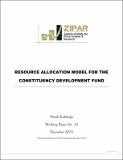| dc.description.abstract | Detailed information on the location of those with the greatest need for publicly provided social services
may be the most valuable information policy makers could use to allocate resources, plan and budget. More
often than not, the emphasis has been on evaluating the distribution of poverty, as defined by income
insufficiency, to inform resource allocation. Theoretically, measures of household wealth can be reflected by
income, consumption or expenditure information. However, the collection of accurate income and
consumption data requires extensive resources for household surveys. As regards, it may be more
appropriate to focus on relative material and social deprivation than narrowly defined poverty. More
importantly when one wants to evaluate the distribution of relative disadvantaged status between quite
small geographic areas (e.g. Constituency), it is best to use data derived from the census, given that it is the
most inclusive and representative of all household surveys. More overall, income from surveys are measures
more reflective of short-run household’s wealth or living standard, inadequate for estimating long-run
poverty accurately whereas other socio-economic and demographic census variables are regarded as much
more reliable to estimate long-run deprivation.
The research reported on in this paper has calculated a composite index of deprivation using 2010 Census
data, drawing on the experience of similar initiatives in other countries and using internationally accepted
statistical techniques. This index shows that the socio-demographic variables that have the greatest
influence on deprivation in the Zambian Constituencies are: lack of access to piped water and toilets,
traditional dwelling whose material for walls, roofs and floor are not solid, lack of access to electricity, solar
power, gas or bio fuel, living in a female headed household, being a child under the age of 5 years, being
illiterate, and being unemployed youth. The deprivation index was calculated at the constituency level. The
highest levels of deprivation are experienced in the Sinkongo, Luapula, Lukulu-West, Sinjembela and
Zambezi-West constituencies. To equalize development across the country there is need for policy
intervention to re-allocate more resources in these need areas. The analysis shows that deprivation is
skewed to rural dominated constituencies. | en_GB |


